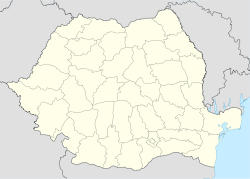Huedin
| Huedin Bánffyhunyad |
|||
|---|---|---|---|
 |
|||
|
|||
| Location on Romania map | |||
| Coordinates: Lua error in package.lua at line 80: module 'strict' not found. | |||
| Country | |||
| County | |||
| Status | Town (oraș) | ||
| Government | |||
| • Mayor | Nicolae Chiş (National Liberal Party) | ||
| Area | |||
| • Total | 61 km2 (24 sq mi) | ||
| Population (2011)[1] | |||
| • Total | 9,346 | ||
| • Density | 150/km2 (400/sq mi) | ||
| Time zone | EET (UTC+2) | ||
| • Summer (DST) | EEST (UTC+3) | ||
| Website | http://www.primariahuedin.ro | ||
Huedin (Hungarian: Bánffyhunyad, Hungarian pronunciation: [ˈbaːnfihuɲɒd] (![]() listen); German: Heynod; Yiddish: הוניוד or הוניאד) is a town in Cluj County, Romania.
listen); German: Heynod; Yiddish: הוניוד or הוניאד) is a town in Cluj County, Romania.
Huedin is located at the northern edge of the Apuseni Mountains. It is surrounded by the villages of Nearşova, Domoşu, Horlacea and others. The town administers one village, Bicălatu (Magyarbikal). Lately, Huedin has started to be known for its ecotourism initiatives.
Population
| Historical population | ||
|---|---|---|
| Year | Pop. | ±% |
| 1930 | 5,401 | — |
| 1948 | 5,134 | −4.9% |
| 1966 | 7,834 | +52.6% |
| 1977 | 8,378 | +6.9% |
| 1992 | 9,961 | +18.9% |
| 2002 | 9,955 | −0.1% |
| 2011 | 9,346 | −6.1% |
| Source: Census data | ||
The 2011 (census data) of the town's population counted 9346 people, of which 59.32% were ethnic Romanians, 28.88% ethnic Hungarians and 11.45% ethnic Roma.[1]
History
The town of Huedin was founded in the Middle Ages. From 1330 up until 1848, the landlords of the town were the Bánffy family (see the town's Hungarian name of Bánffyhunyad). The town was part of the Kingdom of Hungary. In 1526, Huedin became part of the Principality of Transylvania and, until 1867, of the Grand Duchy of Transylvania.
The town boasts a strong historical Hungarian heritage. On September 26, 1895, Emperor Franz Joseph visited Bánffyhunyad following the end of Hungarian Army manoeuvres in Transylvania and was given an enthusiastic welcome by the townspeople, who built an arch decorated with the region's flowers and plants for the occasion.[2] In 1910, the town's population was 5194, of whom 90.5% spoke Hungarian. At that time, 57.5% were Calvinist, 20.7% Jewish, and 10% Roman Catholic. From 1918 to 1940, the town was part of Romania. From 1940-44, it was again part of Hungary, due to the Second Vienna Award. The town is home to a 13th-century Gothic Reformed Church.
Accessibility
The town is accessible by CFR trains from Cluj-Napoca and other cities, such as Oradea, Timişoara, Satu Mare, Braşov, Ploieşti, Bucharest, and Budapest. Huedin also lies on the line connecting Budapest to Oradea and Cluj-Napoca.
Images
-
Reformed church in Huedin.
Notes
- ↑ 1.0 1.1 (Romanian) Populaţia stabilă după etnie - judeţe, municipii, oraşe, comune, National Institute of Statistics; accessed July 15, 2015
- ↑ Lua error in package.lua at line 80: module 'strict' not found.
External links
| Wikimedia Commons has media related to Huedin. |
- (Romanian) Huedin Business Center





